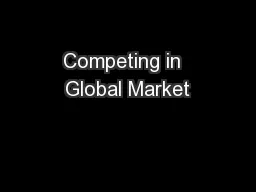PPT-Competing in Global Market
Author : kittie-lecroy | Published Date : 2019-02-13
Chapter 4 Course BUS 101 Lecturer Aunima Nazmun Nahar NNA Overview Why nations trade Absolute and comparative advantage Barriers to international trades Types
Presentation Embed Code
Download Presentation
Download Presentation The PPT/PDF document "Competing in Global Market" is the property of its rightful owner. Permission is granted to download and print the materials on this website for personal, non-commercial use only, and to display it on your personal computer provided you do not modify the materials and that you retain all copyright notices contained in the materials. By downloading content from our website, you accept the terms of this agreement.
Competing in Global Market: Transcript
Download Rules Of Document
"Competing in Global Market"The content belongs to its owner. You may download and print it for personal use, without modification, and keep all copyright notices. By downloading, you agree to these terms.
Related Documents














